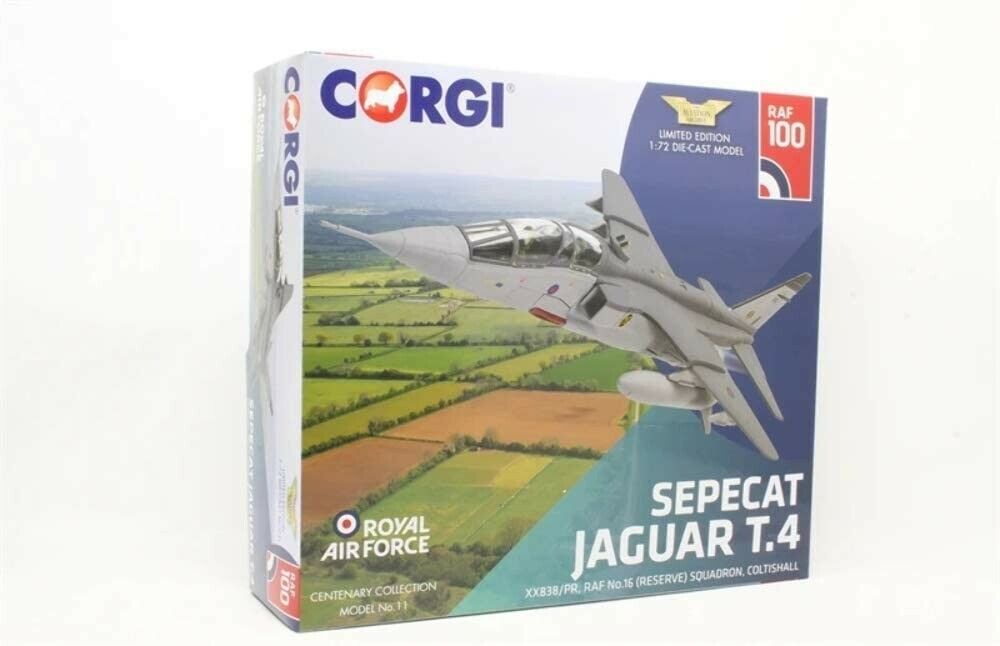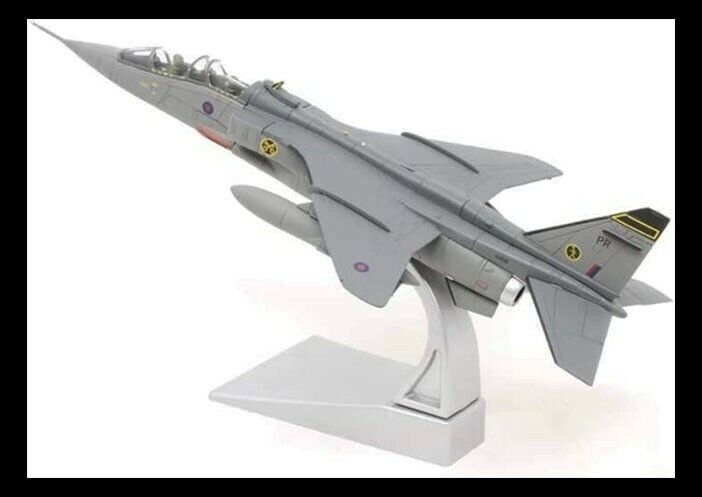-40%
CORGI SEPECAT Jaguar T.Mk 4 Airplane RAF Coltishall 1/72 AA35415 MIP LTD
$ 44.11
- Description
- Size Guide
Description
Corgi Aviation Archive Collector Series AA35415SEPECAT Jaguar T.Mk 4 Diecast Model
RAF No.16 (R) Sqn, XX838, RAF Coltishall, England
Limited Edition
1000
Pieces Worldwide
1:72 Scale
Length
Width
SEPECAT Jaguar T.Mk 4
9.25"
4.75"
If it were at all possible to give the attractive SEPECAT Jaguar even better looks than it already possessed, the two seat training variant of the aircraft is regarded by many enthusiasts as being one of the most aesthetically pleasing post war jets to see service with the Royal Air Force. Although the tandem student/instructor configuration of training Jaguars appeared to make this variant significantly longer than the more numerous single seat big cats, the aircraft was actually only 2ft 3.5 inches greater in length, even though their appearance was that of a much more slender and elegant aeroplane. SEPECAT Jaguar T.4 XX838 was built in 1975 to T.2A (trainer) standard and subsequently became one of only eleven airframes to receive further upgrade to the final T.4 training variant of the aircraft, remaining with the RAF until the Jaguar was finally withdrawn from service in late 2006. For this RAF 100 series release, she is presented wearing the colours of RAF No.16 (Reserve) Squadron, which acted as the Operational Conversion Unit for future Jaguar pilots, following its reformation at RAF Lossiemouth in 1991. With its heritage as one of the oldest Royal Air Force Squadrons, the units badge features two crossed keys, one gold and one black, which can be traced back to the formation of the unit at Saint-Omer in 1915 and the Squadron's proud army cooperation role. Providing vital aerial reconnaissance of enemy positions over the Western Front during the Great war, the two keys represent the Squadron's effectiveness at unlocking the enemy's secrets by day or by night, providing military planners with the very latest aerial battlefield information, at a time when the aeroplane was fast becoming an essential tool of war.
Although the Jaguar was originally envisaged as a supersonic jet trainer for the RAF, replacing their ageing Gnat and Hunter training fleets, the attractive cost sharing potential of an Anglo-French collaborative development programme would soon lead to additional requirements being placed on the resultant aircraft. What the project finally produced was a rugged and highly effective strike, close air support and tactical reconnaissance aircraft, which at its height, equipped six RAF squadrons and an OCU at bases in Britain and Germany, serving with distinction over a career spanning almost 33 years. RAF Coltishall in Norfolk became synonymous with Britain's Jaguar Force, welcoming the first aircraft in August 1974 and bidding farewell to the final RAF Squadrons in April 2006. The famous Squadron markings of Coltishall based No.16 (Reserve) Squadron received an interesting unofficial update during the 1960s, taking inspiration from a fictional literary amateur detective/lovable rogue Robin Hood type figure, brought to the TV screen by the extremely suave Roger Moore. With the unit originally forming at Saint-Omer, in the Pas-de-Calais region of France, the Squadron were always colloquially referred to as 'The Saints' and as Roger Moore's character 'Simon Templar' was also known as 'The Saint', the Squadron were keen to align themselves with this particularly stylish and quintessentially British TV phenomenon. The universal branding featured on The Saint TV programme was a stick man with a suitably positioned halo and the Squadron used a stylised version of this logo to adorn a number of their Jaguars over the years, to the delight of aviation enthusiasts and Airshow crowds all across the country. RAF No.16 Squadron's unofficial Saint motif would be painted in gold on a black background, representing the two coloured keys which feature on the Squadron's badge, serving to further reaffirm the famous heritage of this former Royal Flying Corps unit.
SEPECAT Jaguar T.Mk 4
Designed to meet a British requirement for an advanced supersonic jet trainer and a French requirement for an inexpensive trainer and light attack aircraft, the SEPECAT Jaguar first flew on September 8, 1968. Early in its development the trainer requirement was dropped and the Jaguar went on to become a capable close air support, tactical reconnaissance and strike aircraft. This swept-wing aircraft was one of the first Anglo-French military aircraft projects and was used heavily by the French Air Force, which didn't officially replace it as its main strike/attack aircraft until 2005. It also served the RAF until 2007.
Corgi's 1:72 scale Jaguars are constructed using very little plastic and feel surprisingly heavy. Both the fin and elevators are die-cast metal, a feature that is unusual in most similar models. Among the model's notable features are movable elevators that rotate in unison, simulated stainless-steel heat shielding around the engine exhaust and the separately applied v-shaped transparent lens cover on the nose camera. The snug-fitting large, metal landing gear installs quickly and easily for ground display. The mold allows for the single-seat and the long, slender two-seat trainer variants to be produced.










